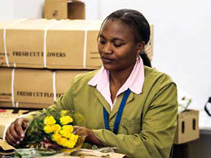 The share of the rejected stems in the Kenyan supply chain from farm to the market with the current packaging is roughly 20% on average. A more standardized box will help us save on this. However growers could not well agree on what should be the first step in piloting a new box. While most agreed that the cost of the box would be the main consideration, others felt processes and handling procedures in the supply chain should dictate the standard box. Floriculture Magazine spoke to some of the industry stakeholders. Below are the excerpts:
The share of the rejected stems in the Kenyan supply chain from farm to the market with the current packaging is roughly 20% on average. A more standardized box will help us save on this. However growers could not well agree on what should be the first step in piloting a new box. While most agreed that the cost of the box would be the main consideration, others felt processes and handling procedures in the supply chain should dictate the standard box. Floriculture Magazine spoke to some of the industry stakeholders. Below are the excerpts:
Statistics available reveal that Kenya is losing millions in Cool Chain Management (Pack house, refrigerated Lorries’ road transport, cargo handling at the airport and cargo plane of flowers). Most of these losses are occasioned by the type of boxes used in the cool chain management and how they are handled. This makes our flowers less competitive in the market. Carton manufacturers must invest a lot to provide solution for these losses in addition to ensuring that there is no compromise on quality as well as training growers on cool chain and carton handling.
Growers Involvement
The second edition of Flower Logistics Africa 2017 had a full house representing a cross-section of the entire value chain of flower trade. The discussions revolved around the need for standardisation that will enhance exports and gain traction for Kenya’s flower industry in the global market. Jane Ngige, chief executive officer of Kenya Flower Council (KFC) who was part of a panel discussion, emphasised the need for a single box standard for the flower industry. “Now growers follow different standards that are set over the period, by the box manufacturers and for uniformity, there is need to consult the growers on the right specifications and come up with a standard box,” she said.
Speaking during the conference, one of the leading box manufacturers in the country Mr. Parit Shah of Silpack Industries Ltd said the driving concern should be the desire to give growers the best quality boxes. Adding, “naturally growers have become part and work alongside their box manufacturer. Growers have the authority over product innovation and planning, production scheduling and delivery of the box. They point out every single thing that must be improved. Growers also arrange training of their pack house staff and the nature of their training”.
Mr. Parit pointed out that technology and innovation are the backbone of most of box manufacturing processes. It is in this respect that the technical teams and the pack house staff remain major contributors in any achievement. They actively participate in coming up with the operational procedures and are instrumental in evaluations. Growers, who have become part of the action team, also spearhead programs for minimising the damages because they have an idea on how flowers are packed and transported.
Leading box manufacturers have also joined hand with other stakeholders and invested a lot on cool chain training and handling of boxes. The training is tailored to ensure growers product have none or minimal bruises before reaching the customer. In addition, it also ensures minimal friction if any during transport.
“A bruised product or neck bend product will be less competitive and fetch less than the market price”, says Elizabeth Kimani, General Manager Sian Roses. Growers need to understand inserting of SFKs and handling of the flower box before and after packaging. In addition, the company trains on storage of the boxes.
Customer Service.  Box manufactures do not leave growers with any packaging hassles but time concentrate on their core activities. As a packaging solutions provider; they do not just offering a box. Their approach is different. “We challenge, innovate and inspire our customers. Our consultative approach is in finding alternative solutions to packaging needs. We add value by showing how costs can be driven down while still retaining a competitive edge”, Says Ms. Lucy Kinyanjui of EAPI.
Box manufactures do not leave growers with any packaging hassles but time concentrate on their core activities. As a packaging solutions provider; they do not just offering a box. Their approach is different. “We challenge, innovate and inspire our customers. Our consultative approach is in finding alternative solutions to packaging needs. We add value by showing how costs can be driven down while still retaining a competitive edge”, Says Ms. Lucy Kinyanjui of EAPI.
One of the challenges facing carton Manufactures is the movement of goods from the factory to the customer’s premises and or delivery points. This can be attributed to poor infrastructure and neverending traffic jams. Cartons are transported to customers in two ways. Some customers, mainly from the flower sector prefer collection on return after delivery of flowers at JKIA. Box manufacturers also offer delivery services to their customers.
Company Investments
Box manufactures in Kenya are currently shifting to a new technology state –ofthe- art machines and corrugators. The corrugators are capable of producing very low grammage single wall boards to heavy duty double wall boards. Another benefit is its ability to do coating of the boards which helps in improving of water resistance. The conversion die-cutting machines have a capability of both flat bed and rotary die-cutting and can print up to six colours. The folder Gluer is capable of printing up to full colours and together with stitchers meets all the regular slotted cartons (RSC) requirements of our customers.
Light weight box concept
“The future of boxes is in ensuring that our customers save on freight and quality” says Mr Parit Shah of Silpack Industries Ltd. Adding, “Innovation is the key to production as well as processing of knowledge”.
Armed with this, two of the box manufactures have introduced a box that will save the customer millions of shillings paid in freight. The light weight concept is a complete reversal from the conventional heavy waste-based fluting board. The box which is lighter will fetch lower freight cost and save money for the grower. Numerous researches through leading growers in Kenya have shown that growers will save almost 20% of their current freight cost.
Additionally, the light box drop lightly compared to the heavy box hence minimal impact compared to the heavy. This will translate to strength retention in the cool chain. The lighter box is done with a specialised fluting paper called semichemical fluting, which enables it to perform better in the cool chain and increase its residual strength. Box deterioration is also better hence impact of the packed product reduced.
Manufacturing Challenges
“There are high costs of operations in Kenya which cannot be ignored such as electricity, finance, communications, infrastructure and custom duties when importing through the port, all these makes it clear why local packaging suppliers cannot produce and sale at internationally competitive rates”, Says Nick. Paper prices are such that they constitute over 60% of the cost of the manufactured carton, so there is little scope for great flexibility on selling prices. To be globally competitive, the government should cushion some of these expenditures.
Manufactures are also engaging with growers to try and standardize the cartons. Looking at the standard box today, it has many different concepts on die cuts. While all agree that the role of a die cut is ventilation, there is no agreement on the shape and the number of die cuts. Some growers prefer three while others go for two. The shapes range from rectangle, to circle or semi-circle. Standardizing them will cut more cost to the growers.
Growers who are mostly driven by the costs should accept the responsibility and lead the path on the innovation and development of a standard box. They should advice on the right specifications and release themselves from the mercies of the flower consumers and unnecessary dictatorship from the market. This has led to every supply chain pushing their own boxes which makes manufacturing for the different types very expensive. Colombia who is the main competitors has a standard box and the market has accepted it.


